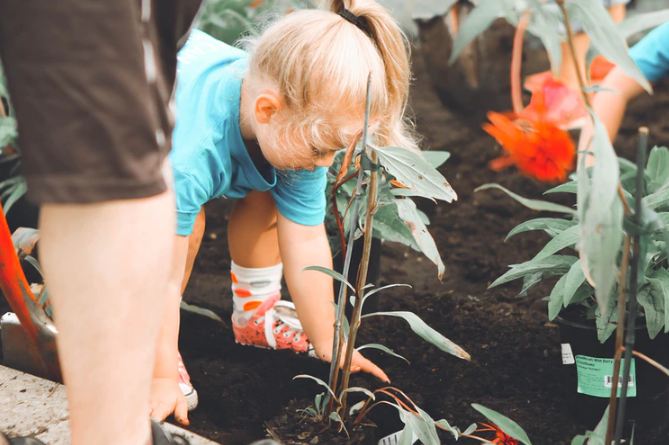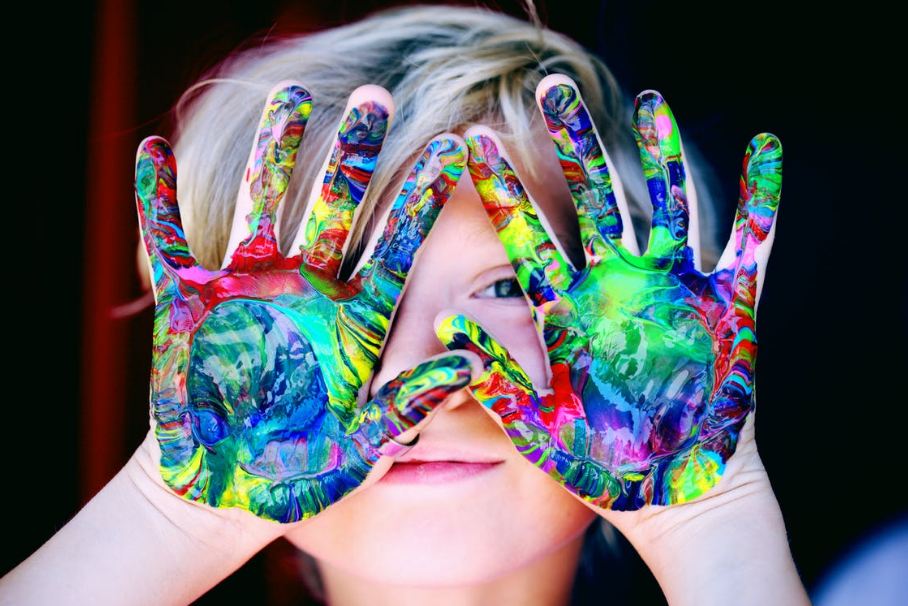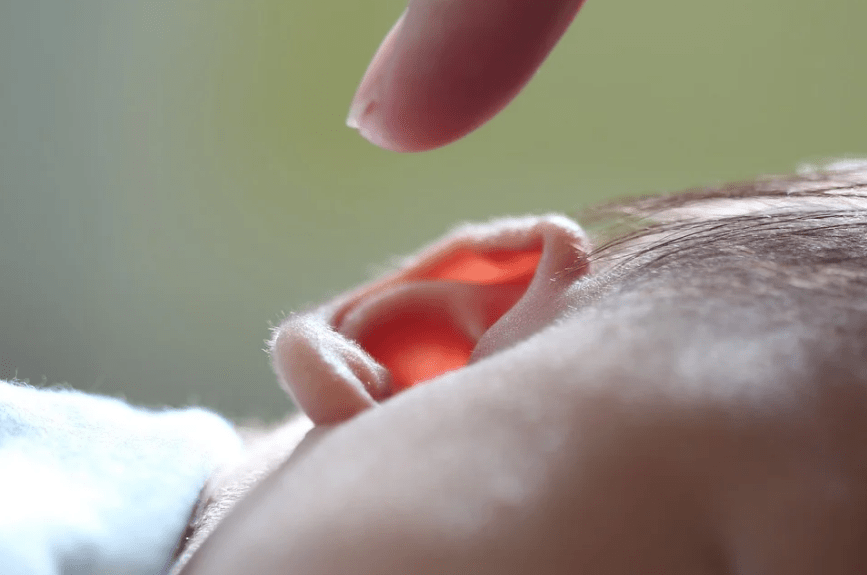How to Encourage Creativity in Kids Through Painting

To foster creativity in children through painting, start by creating an inviting environment with easy access to various art supplies. This setup encourages them to experiment with different techniques and materials freely. Equally important is your supportive attitude towards their efforts. Praise their progress rather than focusing solely on the final product to boost their confidence. Additionally, consider incorporating storytelling into painting sessions, offering themed projects, or displaying their artwork to further inspire their creative exploration.
Benefits of Painting for Kids
Painting offers numerous benefits that significantly contribute to a child's holistic development. Through painting, children enhance their fine motor skills and hand-eye coordination while engaging in creative activities. Holding a paintbrush or mixing colors on a palette involves precise movements, which help refine their motor abilities. This practice not only supports physical growth but also enriches cognitive development.
When kids paint, they enter a world filled with colors, shapes, and textures, stimulating their imagination. This visual exploration allows them to express themselves in ways that words sometimes cannot capture. Experimenting with different techniques and materials teaches them problem-solving and critical thinking skills, essential for overall development.
Furthermore, painting serves as a vital platform for self-expression, enabling children to convey their emotions and thoughts. This form of expression can significantly boost a child's confidence and sense of accomplishment. As they witness their ideas materialize on paper, they gain a greater sense of what they can achieve, further encouraging their creative pursuits. Thus, painting is not merely an activity but a powerful tool for growth and learning.
Creating a Creative Space
To nurture your child's creativity, create a dedicated painting space with well-organized art supplies. Ensure the area is both inspiring and easily accessible, encouraging children to explore their artistic talents independently. A thoughtfully designed creative space can boost their confidence and focus, making painting a joyful and immersive experience.
Art Supply Organization
Creating an organized art supply area with bins, drawers, and shelves makes it easy for kids to access their materials, fostering a more creative atmosphere. When art supplies are neatly arranged, children can explore their art space freely, encouraging spontaneous creativity. Labeling containers with the names of art materials helps kids identify and return items, teaching them organization while maintaining a tidy creative zone.
Designate a specific art area with a table, chairs, and adequate storage. This setup provides a dedicated space where kids can immerse themselves in painting without distractions. Knowing exactly where to find brushes, paints, and paper allows them to start their projects with enthusiasm and focus.
Keeping a variety of paint colors, brushes, and other materials within reach ensures kids can experiment with different textures and techniques whenever inspiration strikes. Displaying their artwork and completed projects in this area further motivates them by showcasing their progress and achievements. This organized approach to art supplies and space not only makes the process enjoyable but also nurtures their artistic development.
Inspiring Environment Design
Once you've arranged the art supplies, focus on designing an inspiring environment that fuels your child's creativity. A dedicated creative space helps your child immerse themselves in their artistic activities. Start by choosing a well-lit area in your home where your child can paint freely without worrying about making a mess. Natural light is ideal, but good quality artificial lighting works well too.
Incorporate elements that make the space inviting and conducive to creativity. Hang colorful artwork or prints on the walls to inspire your child. Ensure the area is comfortable, with child-sized tables and chairs. An easel can also be a great addition to their painting setup.
A well-organized creative space encourages your child to experiment with different painting techniques and styles. Here's a table to help you design an effective and inspiring art room:
| Element | Purpose | Tips |
|---|---|---|
| Natural Light | Enhances mood and visibility | Choose a room with large windows |
| Comfortable Furniture | Ensures comfort and prolonged engagement | Use child-sized tables and chairs |
| Art Display | Sparks inspiration | Hang colorful artwork or prints |
| Storage Solutions | Keeps art supplies organized | Use bins, shelves, and drawers |
| Personal Touches | Cultivates a sense of ownership | Let your child help decorate the space |
Choosing the Right Supplies
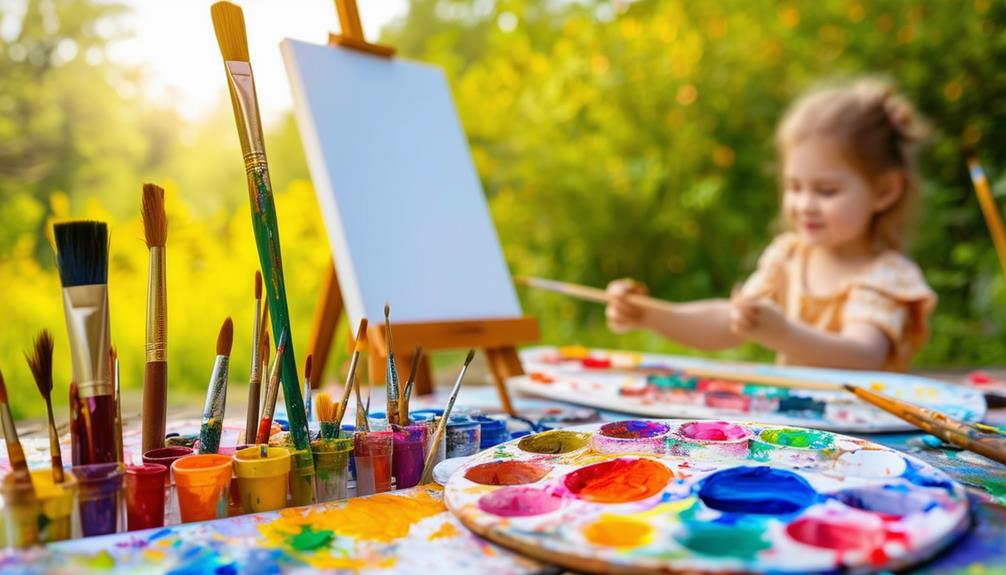
When selecting painting supplies for children, prioritize non-toxic and washable options to ensure both safety and easy cleanup. These art supplies allow children to explore their creativity without harmful exposure and make tidying up simple. Opt for various paint types such as watercolors, tempera, or acrylics, each offering unique techniques and effects for kids to experiment with.
A diverse selection of brushes in different sizes and shapes will enable young artists to try out various strokes and styles. Small brushes are ideal for detailed work, while larger ones can cover more area quickly. Beyond brushes, include tools like sponges, cotton swabs, or even their fingers to create unique textures and patterns. This variety can inspire new ideas and methods for your budding painters.
Quality paper or canvas is essential for a satisfying and durable end product. Robust surfaces can handle different paint types and techniques better, providing a more rewarding experience. By investing in the right supplies, you create a strong foundation for your children's creative journey, allowing them to fully express their artistic potential.
Encouraging Experimentation
Foster an environment where your child feels safe to explore and experiment. Encourage them to try new techniques without fear of making mistakes, treating each imperfection as a valuable learning opportunity. Celebrate their willingness to mix colors and use different tools, enhancing both their creativity and confidence.
Safe Creative Environment
Foster a space where children feel comfortable experimenting with painting techniques without fear of mistakes. Allowing them to engage in diverse art activities without judgment encourages them to learn from errors and discover their unique style.
Encourage exploration through various painting techniques, such as splatter painting or using unconventional tools. Let them mix colors freely and explore different styles, focusing on the joy of the creative process rather than the final product.
Here are some tips to create that safe, creative environment:
- Provide a variety of tools: Offer brushes, sponges, and even household items for painting.
- Set up a dedicated art space: Create a corner with drop cloths, easels, and ample paper or canvas.
- Encourage color mixing: Allow kids to blend paints to discover new shades and tones.
- Focus on the process: Emphasize the enjoyment of painting rather than the outcome.
Celebrating Imperfections
Celebrating imperfections in children's artwork nurtures their creativity by allowing them to experiment and learn without fearing mistakes. When kids understand that their art doesn't have to be flawless, they're more inclined to try new things and take risks. This mindset of embracing imperfections fosters a sense of creative freedom, enabling them to explore diverse painting styles and techniques.
Encouraging experimentation in painting means providing a safe space where children can freely express themselves. When you celebrate their unique and unconventional approaches, it helps them develop confidence and resilience. They learn that creativity is about the process, not just the final result, which is a valuable lesson in both art and life.
Trying New Techniques
Encouraging children to experiment with new painting techniques can unlock a world of creative possibilities, ignite their imagination, and enhance their artistic skills. When children are motivated to try different methods, they can discover and refine their unique artistic styles. This process nurtures creativity, problem-solving abilities, and curiosity.
Here are some ideas to help your child embrace artistic experimentation:
- Mixed Media: Combine materials like watercolor, acrylics, and pastels in one artwork to introduce your child to various textures and effects.
- Alternative Tools: Encourage the use of sponges, fingers, or natural items like leaves to paint, demonstrating how different tools produce unique results.
- Abstract Techniques: Allow your child to explore methods like splatter painting or pouring, promoting free expression without the pressure of perfection.
- Color Mixing: Teach your child about color theory and let them create their own shades, deepening their understanding of color relationships.
Focusing on the Process
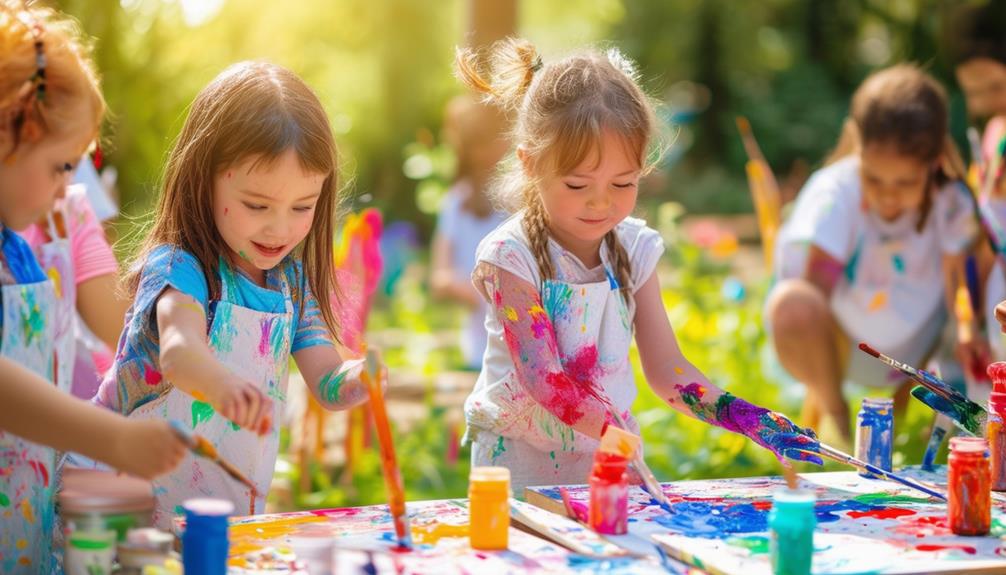
Focusing on the creative process in painting encourages children to experiment freely and discover new techniques. Encourage your child to engage in open-ended projects where the journey matters more than the final product. This approach allows them to explore various techniques, colors, and styles without the pressure of achieving a specific outcome, fostering self-expression and the development of their unique artistic voice.
When children concentrate on the process, they learn to appreciate the act of creation itself. Blending colors to discover new shades or experimenting with different brush strokes turns every step into an exploration opportunity. Emphasize that there's no right or wrong way to paint, helping them understand that mistakes are part of the learning experience and can lead to unexpected, beautiful results.
Creating a non-judgmental environment is crucial. Celebrate their efforts and creativity rather than critiquing the final product. Valuing the artistic process builds confidence and helps children find joy in their personal growth through painting. This mindset encourages lifelong creativity and a love for artistic exploration.
Praising Efforts, Not Results
Praising children's efforts in painting encourages them to keep experimenting and exploring different techniques. Focusing on the process rather than the end result helps children develop a positive attitude towards creativity and learning.
Acknowledging their effort enhances self-confidence and motivation to continue creating. When children feel their efforts are valued, they enjoy the journey of artistic expression rather than just seeking perfection. This approach fosters a love for creativity and promotes artistic exploration.
Here are a few ways to praise your children's efforts in painting:
- Highlight their persistence: Mention how you noticed they kept trying even when it became challenging.
- Appreciate their imagination: Point out the unique choices they made with colors or techniques.
- Recognize their progress: Comment on how their skills have advanced over time.
- Support their enthusiasm: Show excitement for their passion, reinforcing that their efforts matter.
Displaying Their Artwork
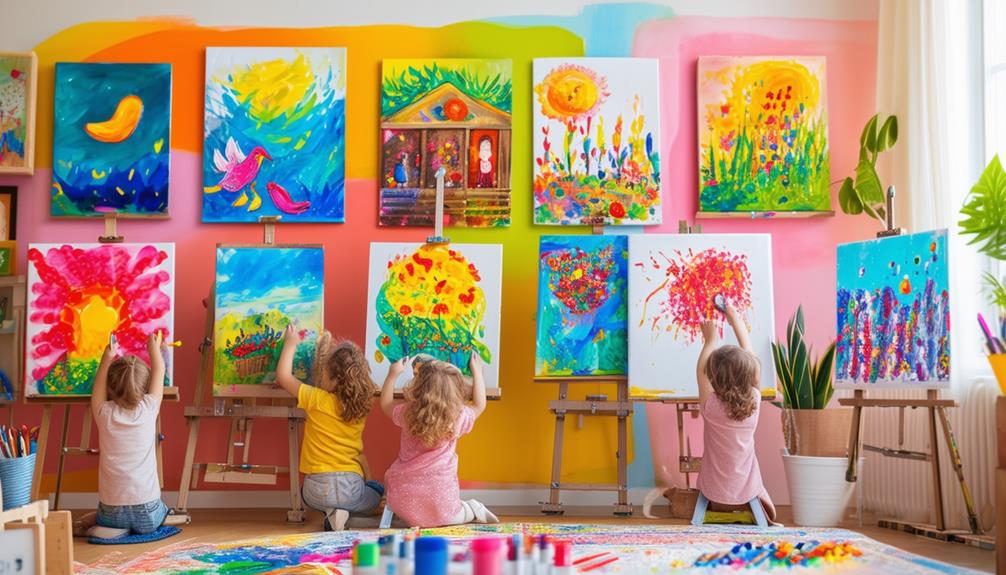
Displaying your child's artwork prominently at home can significantly enhance their confidence and enthusiasm for painting. Showcasing their creations promotes a sense of accomplishment and self-worth, validating their efforts and encouraging them to continue exploring their artistic talents.
Imagine the joy on your child's face when they see their artwork framed on the living room wall or featured in a dedicated gallery space at home. This act sends a powerful message: their work is valued and appreciated. Such validation can inspire them to push their creative boundaries.
| Benefits | Examples |
|---|---|
| Boosts Confidence | Displaying artwork in the living room |
| Inspires Creativity | Rotating new pieces in a gallery space |
| Cultivates Pride | Sharing art with family and friends |
Sharing your child's artwork, whether through home displays or on social media, cultivates a sense of pride and offers opportunities for positive feedback. By consistently displaying their creations, you nurture their passion for painting and reinforce the idea that their creative efforts truly matter.
Incorporating Art History
Introducing art history into your child's painting activities can spark their creativity and expand their artistic skills. Encourage them to explore renowned artists, study various art movements, and visit art museums. This exposure will help them appreciate the rich legacy of artistic expression and motivate them to try new techniques in their own creations.
Explore Famous Painters
Introduce your kids to the captivating world of art by exploring the lives and works of famous painters like Vincent van Gogh and Frida Kahlo. These iconic artists can inspire children to experiment with various styles and techniques in their own artwork. As an art teacher, you can use examples from these painters to demonstrate how they conveyed emotions and stories through their masterpieces.
By examining the biographies and artistic journeys of these renowned figures, children can develop a deeper appreciation for art and its societal impact. Discussing the challenges van Gogh faced or the unique perspectives Kahlo brought to her work can ignite creativity and imagination in young artists.
Here are some engaging ways to incorporate famous painters into your painting activities:
- Art Projects: Encourage kids to create their own versions of famous paintings, allowing them to explore the techniques used by van Gogh or Kahlo.
- Storytelling: Share interesting anecdotes about the lives of these artists to make art history more relatable and exciting.
- Museum Visits: Plan trips to local museums or virtual tours to view famous artworks up close.
- Interactive Discussions: Hold sessions where kids can discuss their observations and feelings about these iconic works, fostering a deeper connection to art.
Study Art Movements
By drawing inspiration from celebrated painters, you can enrich your children's artistic exploration by introducing them to various art movements such as Impressionism, Cubism, and Surrealism. This not only broadens their creative horizons but also provides insight into the development of painting as a form of expression. Through studying art history, children can learn how artists convey ideas through their work.
Start by exploring the key characteristics of each art movement. For example, Impressionism emphasizes light and color, often portraying everyday scenes. Explain to your children how Impressionists like Monet captured fleeting moments with expressive brush strokes. Move on to Cubism, where artists like Picasso deconstructed objects into geometric shapes, which promotes abstract thinking. Lastly, explore Surrealism, where dreams and reality merge, as evident in Dalí's imaginative pieces.
Discussing these movements and their prominent artists can ignite curiosity and creativity in your young painters. Encourage them to create their own unique pieces inspired by these styles. This approach not only deepens their appreciation for art but also inspires them to experiment with new techniques and perspectives. By integrating art history into their painting activities, you nurture a vibrant and imaginative environment for your children.
Visit Art Museums
Visiting art museums provides children with the opportunity to experience diverse artistic styles and historical periods firsthand. These visits expose them to various art techniques and the cultural significance of art throughout history, greatly enhancing their creativity. Viewing famous artworks in person can be extremely inspiring, offering real-world examples of artistic expression.
To maximize the benefits of museum visits and boost your child's creativity, consider the following tips:
- Interactive Tours: Many museums offer guided tours tailored specifically for kids, making art history engaging and accessible.
- Art Workshops: Check if the museum provides hands-on workshops where children can create art inspired by the exhibits.
- Storytelling Sessions: Look for storytelling events that link historical periods and artistic styles, helping children understand the context behind the artwork.
- Sketching Opportunities: Encourage your child to bring a sketchbook to draw their favorite pieces, fostering a deeper connection with the art they see.
Inspiring With Nature
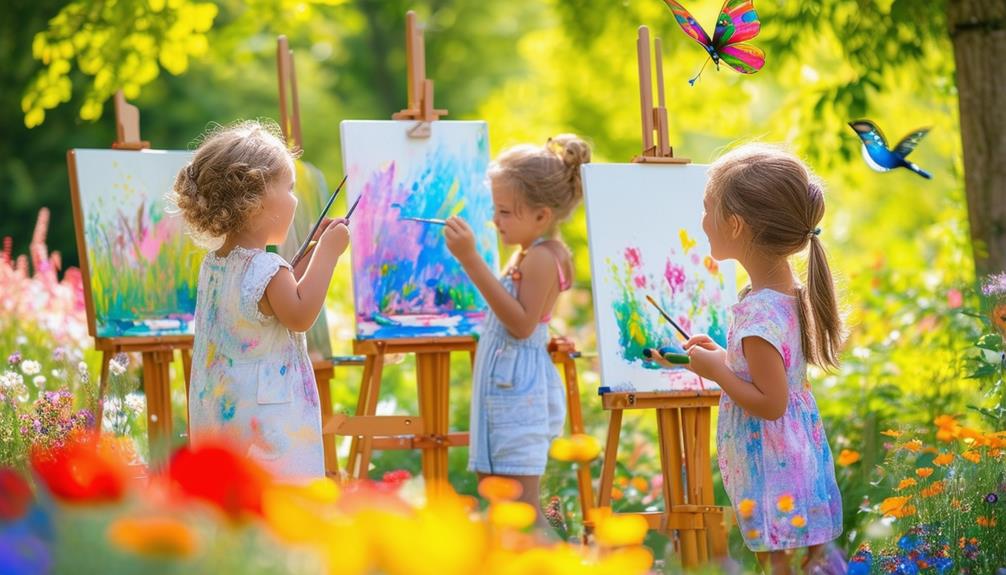
Nature offers a wealth of inspiration for kids, with its endless beauty, vibrant colors, and varied textures. Encouraging children to observe and replicate the natural world can ignite their creativity. Imagine them painting the intricate patterns of a butterfly's wings or the shifting colors of a sunset. Nature provides an ever-changing palette that keeps their creativity flowing.
Outdoor painting activities foster a deep connection with nature. When kids paint outside, they immerse themselves in the environment, experiencing the sights, sounds, and scents firsthand. This direct contact stimulates their senses and sparks their imagination. They might notice the delicate veins in a leaf or the way light dances on water, details that can translate into their artwork.
Additionally, painting nature scenes helps kids develop their observational skills. They learn to see the world in a new way, appreciating small details and the broader picture. From towering trees to tiny insects, every element becomes a potential subject for their canvas. This not only enriches their artistic abilities but also instills a greater appreciation for the environment around them.
Promoting Open-Ended Projects
Open-ended painting projects provide children with the opportunity to express their creativity without the constraints of rigid guidelines. These projects are excellent for nurturing creativity, as they encourage independent thinking and problem-solving. Without strict rules, kids can explore various techniques, colors, and styles, leading to a richer and more diverse artistic experience.
Here are the benefits of encouraging open-ended projects:
- Promotes Independent Thinking: Kids learn to make decisions and solve problems creatively.
- Encourages Self-Expression: They can communicate their thoughts and emotions through their unique artistic choices.
- Builds Confidence: Completing a project independently gives them a sense of accomplishment.
- Emphasizes Process Over Product: Focusing on experimentation fosters a love for art and learning.


